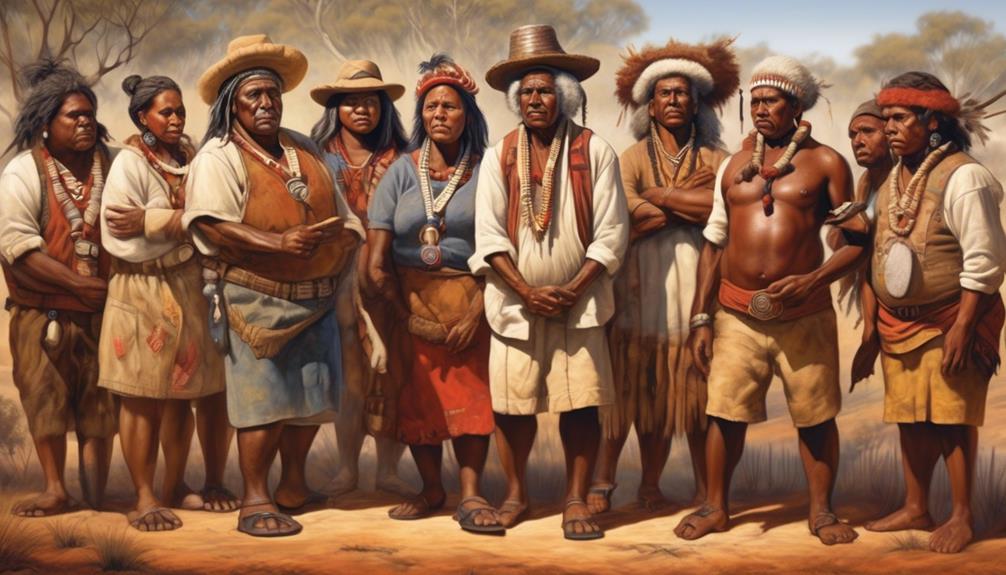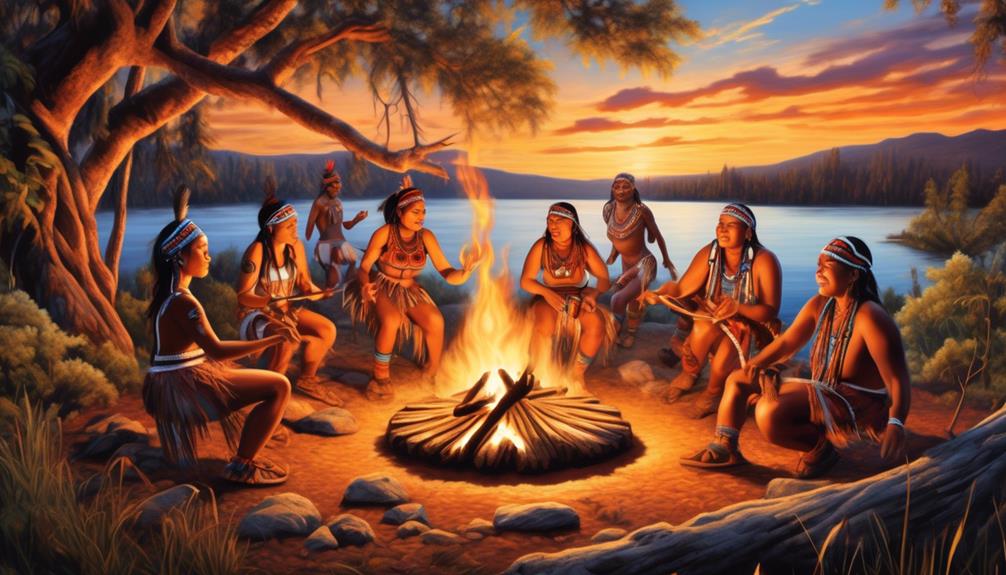Why did British settlers fail to sign a treaty with Indigenous Australians?
The complex historical dynamics surrounding this question have sparked much debate and scrutiny. As we explore the various factors at play, from the cultural misunderstandings and communication barriers to the British government's policies and intentions, a deeper understanding of this pivotal period emerges.
The absence of a treaty holds critical implications for the sovereignty and land rights of Aboriginal Australians, shedding light on a significant aspect of their history that warrants our attention.
Key Takeaways
- British colonization of Australia led to displacement and mistreatment of Aboriginal Australians.
- The imposition of Western ideologies, languages, and legal systems resulted in cultural clash and communication barriers between British settlers and Aboriginal Australians.
- British government policies aimed at land dispossession and erasing Aboriginal identities and traditions.
- Aboriginal Australians actively resisted colonial rule through armed uprisings, strategic use of land knowledge, and defense of their culture and way of life.
Historical Context of Colonization
During the 18th and 19th centuries, British colonization of Australia was marked by the displacement and mistreatment of Aboriginal Australians, laying the foundation for a complex and fraught history.
The process of cultural assimilation was forced upon the Aboriginal people, eroding their traditional ways of life, belief systems, and languages. This deliberate erasure of indigenous culture not only deprived the Aboriginal Australians of their identity but also inflicted deep emotional and psychological wounds that continue to resonate through generations.
Land dispossession was another grim reality of British colonization, as the settlers seized vast territories that had been the ancestral homes of the Aboriginal people for thousands of years. This not only stripped them of their livelihoods but also disrupted their spiritual connection to the land.
The devastating consequences of land dispossession and cultural assimilation have reverberated through the years, leaving a legacy of intergenerational trauma and social inequality.
Understanding this historical context is crucial in acknowledging the deep-seated injustices faced by Aboriginal Australians and in working towards healing, reconciliation, and empowerment.
Cultural Misunderstandings and Communication Barriers

The lasting impact of British colonization on Aboriginal Australians has contributed to a myriad of cultural misunderstandings and communication barriers that continue to shape their experiences today. Miscommunication and cultural clash have been prevalent due to the stark differences in cultural norms, values, and ways of life between the British settlers and the Aboriginal people.
The imposition of Western ideologies, languages, and legal systems created significant hurdles in effective communication and understanding. The lack of effort to learn and respect the Indigenous languages and traditions further exacerbated these barriers, deepening the divide between the two communities.
Furthermore, the power dynamics established during colonization meant that the Aboriginal Australians were often marginalized and disempowered, leading to a lack of agency in expressing their perspectives and needs. This imbalance hindered the development of mutual understanding and constructive dialogue.
As a result, the legacy of these communication barriers and cultural misunderstandings persists, impacting the socio-economic, political, and emotional well-being of the Aboriginal communities. Understanding and addressing these historical communication issues is crucial in fostering genuine reconciliation and building a more inclusive and equitable society.
British Government Policies and Intentions
With a calculated disregard for the sovereignty and rights of the Aboriginal Australians, British government policies and intentions were driven by a desire to assert dominance and control over the land and its original inhabitants. This overarching goal shaped their approach to interactions with the Indigenous peoples, resulting in a series of detrimental policies and actions that perpetuated the subjugation of the Aboriginal Australians.
- Territorial Expansion: The British government sought to expand its territorial influence and secure valuable resources, leading to the enactment of policies that facilitated the dispossession of Aboriginal lands.
- Assimilation Efforts: Settler policies aimed to assimilate Aboriginal Australians into European culture, effectively erasing their distinct identities and traditions, in an attempt to exert further control over the Indigenous population.
- Legal Frameworks: The implementation of legal frameworks, such as the doctrine of terra nullius, denied the existence of Aboriginal land rights, providing a legal basis for the seizure of Indigenous territories.
- Social Engineering: The government's intentions included the reorganization of Aboriginal societies according to British ideals, undermining traditional governance structures and social systems.
The examination of British government intentions and settler policies reveals a pattern of deliberate marginalization and exploitation, underscoring the systemic injustices endured by the Aboriginal Australians.
Aboriginal Resistance and Response

Despite facing overwhelming odds and enduring systemic injustices, the Aboriginal Australians displayed unwavering resilience and determination in their resistance against British colonial rule. Their resistance was a powerful response to the colonial violence and dispossession they experienced. The Aboriginal people fiercely defended their lands, culture, and way of life, demonstrating remarkable strength in the face of relentless oppression.
Aboriginal resistance took various forms, including armed uprisings, guerrilla warfare, and strategic use of their deep knowledge of the land. These acts of resistance weren't only a means of physical defense but also a testament to their unyielding spirit and commitment to preserving their heritage. Despite the overwhelming military might of the British colonizers, the Aboriginal Australians tenaciously fought to protect their autonomy and sovereignty.
The resilience of the Aboriginal people in the face of colonial violence serves as a poignant reminder of their courage and fortitude. Their resistance and response to British colonial rule are a testament to their unwavering determination, inspiring admiration and respect. Understanding and acknowledging the depth of their struggle is crucial in honoring their legacy and working towards reconciliation and justice.
Implications on Sovereignty and Land Rights
Amid the Aboriginal resistance and enduring struggle against British colonial rule, the implications on sovereignty and land rights stand as a testament to the ongoing impact of historical injustices and the urgent need for recognition and restitution. The ramifications of the absence of a treaty between British settlers and Aboriginal Australians are profound and continue to shape the lives and experiences of Indigenous peoples today.
- Sovereignty Implications: The lack of a treaty has perpetuated a legacy of eroded sovereignty for Aboriginal communities, as their inherent right to self-governance and autonomy was never formally recognized or respected.
- Land Rights Implications: Without a treaty, Aboriginal Australians were deprived of the opportunity to negotiate and secure their land rights, leading to dispossession, loss of connection to traditional lands, and ongoing disputes over land ownership and usage.
- Inter generational Impact: The absence of a treaty has resulted in intergenerational trauma, as the dispossession and denial of sovereignty continue to affect the social, cultural, and economic well-being of Aboriginal communities.
- Legal and Political Challenges: The failure to establish a treaty has created enduring legal and political challenges, hindering the full realization of Indigenous rights and perpetuating systemic inequalities.
Frequently Asked Questions
What Were the Specific Cultural Misunderstandings and Communication Barriers That Hindered the Signing of a Treaty Between British Settlers and Aboriginal Australians?
Cultural misunderstandings and communication barriers played a significant role in hindering the signing of a treaty between British settlers and Aboriginal Australians. These misunderstandings stemmed from differing worldviews, values, and language.
The lack of mutual understanding and respect deepened the divide, making it difficult to establish common ground for negotiations. Both parties struggled to effectively convey their perspectives, leading to a breakdown in communication and ultimately preventing the successful formation of a treaty.
How Did the British Government's Policies and Intentions Towards Aboriginal Australians Contribute to the Lack of a Treaty Being Signed?
The British policies towards Aboriginal Australians greatly influenced the lack of a treaty being signed. Government intentions often disregarded the cultural barriers and communication issues, leading to misunderstandings and conflict.
The failure to recognize the significance of a treaty perpetuated the historical injustices experienced by the Aboriginal people. Acknowledging these factors is crucial in understanding the impact of British governance on the absence of a formal treaty.
What Forms of Resistance Did Aboriginal Australians Employ in Response to British Colonization, and How Did This Impact the Possibility of a Treaty Being Signed?
Aboriginal resistance to British colonization, including guerilla warfare and cultural barriers, impacted the possibility of a treaty.
The lack of understanding and communication challenges hindered negotiations.
These forms of resistance reflected the deep-rooted connection to their land and culture, making it difficult for the British to establish formal agreements.
The impact of this resistance on treaty negotiations highlights the complex historical dynamics between the British settlers and Aboriginal Australians.
How Did the Lack of a Treaty Affect the Sovereignty and Land Rights of Aboriginal Australians, and What Long-Term Implications Did This Have?
The lack of a treaty significantly impacted the sovereignty and land rights of Aboriginal Australians. Without a formal agreement, their ability to govern themselves and maintain control over their ancestral lands was severely compromised.
This absence of recognition had far-reaching implications, leading to ongoing injustices and struggles for land rights. The failure to establish a treaty continues to reverberate, perpetuating historical injustices and hindering the path towards reconciliation and true equality.
What Efforts, if Any, Were Made by Either Party to Negotiate and Draft a Treaty, and What Were the Key Factors That Ultimately Led to the Failure to Reach an Agreement?
Efforts were made by both parties to negotiate and draft a treaty, but cultural misunderstandings and communication obstacles proved to be significant negotiation barriers. The lack of mutual understanding and empathy hindered the process.
The British settlers' failure to recognize Aboriginal Australians' sovereignty and land rights also contributed to the inability to reach an agreement. This lack of acknowledgment and respect perpetuated the cycle of marginalization and disenfranchisement of the Indigenous people.
Conclusion
In conclusion, the lack of a treaty between British settlers and Aboriginal Australians can be attributed to a complex web of historical, cultural, and political factors.
Despite the efforts of Aboriginal resistance and response, the British government's policies and intentions ultimately shaped the outcome.
As a result, it's estimated that only 3% of Australia's land is owned by Aboriginal people today, highlighting the ongoing impact of the lack of a formal treaty on sovereignty and land rights.
Mary is a passionate writer who brings creativity and a fresh perspective to our team. Her words have the power to captivate and inspire, making her an essential contributor to our content. Mary’s commitment to storytelling and dedication to promoting Indigenous culture ensures that her work touches the hearts of our readers. We’re fortunate to have her as part of our team.










